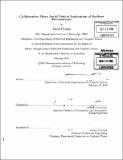| dc.description.abstract | Field personnel, such as soldiers, police SWAT teams, and first responders, face challenging, dangerous environments, often with little advance knowledge or information about their surroundings. Currently, this Intelligence, Surveillance & Reconnaissance (ISR) information is provided by satellite imagery and prior or second-hand experiences. Although satellite imagery is currently the preferred method for gaining Situational Awareness (SA) about an outdoor environment, it has many shortcomings. Unclassified satellite imagery maps available to these field personnel are flat images, with no elevation information and fixed points of view. These maps are often outdated, and, due to shadows and shading, give false impressions of elevations and details of the environment. Critical features of buildings, such as doorways and windows are hidden from view. Combined, these flaws often give field personnel a false mental model of their environment. Given the need of these personnel to simultaneously perform a primary task, such as finding a Person of Interest (POI), as well as explore the environment, an autonomous robot would allow these groups to better perform ISR and improve their SA in real-time. Recent efforts have led to the creation of Micro Aerial Vehicles (MAVs), a class of Unmanned Aerial Vehicle (UAV), which are small and have autonomous capabilities. At most a few feet in size, a MAV can hover in place, perform Vertical Take-Off and Landing, and easily rotate with a small sensor payload. The compact size of these vehicles and their maneuvering capabilities make them well-suited for performing highly localized ISR missions with MAV operator working within the same environment as the vehicle. Unfortunately, existing interfaces for MAVs ignore the needs of field operators, requiring bulky equipment and the operator's full attention. To be able to collaboratively explore an environment with a MAV, an operator needs a mobile interface which can support the need for divided attention. To address this need, a Cognitive Task Analysis (CTA) was performed with the intended users of the interface to assess their needs, as well as the roles and functions a MAV could provide. Based on this CTA, a set of functional and information requirements were created which outlined the necessities of an interface for exploring an environment with a MAV. Based on these requirements, the Micro Aerial Vehicle Exploration of an Unknown Environment (MAVVUE) interface was designed and implemented. Using MAV-VUE, operators can navigate the MAV using waypoints, which requires little attention. When the operator needs more fine-grained control over the MAV's location and orientation, in order to obtain imagery or learn more about an environment, he or she can use the Nudge Control mode. Nudge Control uses Perceived First Order (PFO) control to allow an operator effectively "fly" a MAV with no risk to the vehicle. PFO control, which was invented for MAV-VUE, utilizes a 0th order feedback control loop to fly the MAV, while presenting 1st order controls to the operator. A usability study was conducted to evaluate MAV-VUE. Participants were shown a demonstration of the interface and only given three minutes of training before they performed the primary task. During this task, participants were given search and identify objectives, MAV-VUE installed on an iPhone@ and an actual MAV to explore a GPS-simulated urban environment. Participants performed well at the task, with thirteen of fourteen successfully performing their objectives with no crashes or collisions. Several statistically significant correlations were found between participants' performance and their usage of the interface. Operators who were more patient and had higher scores on a spatial orientation pretest tended to have more precise MAV control. Future design and implementation recommendations learned from this study are discussed. | en_US |
